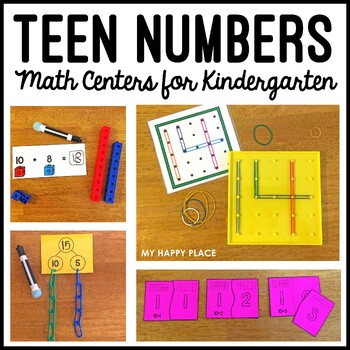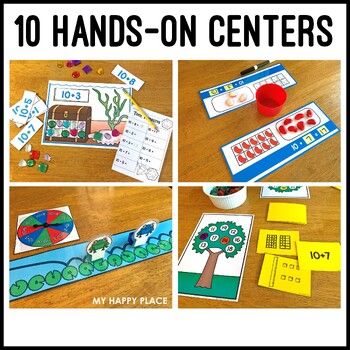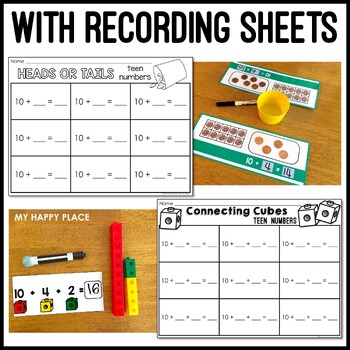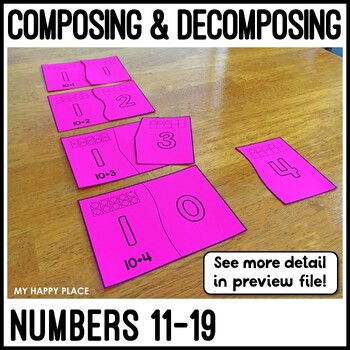Teen Numbers Kindergarten Math Centers – Teen Numbers Centers - Tricky Teens
- PDF
What educators are saying
Also included in
- This bundle of 50 kindergarten math centers will give your young students opportunities to immerse themselves in age-appropriate, standards-based activities, strengthening their understanding of concepts and skills in five domains. What's included in this kindergarten math centers bundle?The followiPrice $28.00Original Price $40.00Save $12.00
Description
Teen numbers can be so difficult for children, but these kindergarten math centers have the engaging and hands-on practice with beginning place value your students need to master the tricky teens! This set includes ten fun and age-appropriate teen numbers centers for your math stations. Using manipulatives that you have on hand and these printable math center materials and recording sheets, your students will be set up with ten different ways to practice identifying, composing, decomposing, and counting to the numbers 11-19!
This set is part of a money-saving, year-long math centers bundle!
These Kindergarten Math Centers Include:
This set includes ten printable teen numbers kindergarten math centers. The activities in this set are intended to help your students master kindergarten number and operations in base ten standards but are appropriate for any child that needs practice with the numbers 11-19. Each center includes:
✔ Teacher Directions (with differentiation ideas)
✔ Student Directions Card (with pictures and “I can” statements)
✔ Illustrated Label (for organization)
✔ Recording Sheets (for accountability, follow-up, assessment, or enrichment)
✔ Printable Task Cards and/or Game Pieces (in color and black and white)
10 Teen Numbers Centers:
▶ Teen Numbers Memory Matching
With a partner or individually, students play a memory matching game to build understanding of various representations of the numbers 11-19 by matching teen numbers to pictures of ten frames, equations, or base ten blocks.
▶ Teen Numbers Puzzles
Students explore place value concepts by assembling two-part puzzles. When placing a digit (1-9) on top of the zero on a ten card, students make a teen number. This center includes versions for three types of math expressions: 10+1=11, 10+1, or 10 and 1.
▶ Teen Numbers Geoboards
Students use rubber bands on geoboards to make numerals. Students can work to match a numeral model or can count the dots on a ten frame card and make the teen number to match.
▶ Linking Teen Numbers
Students use math links to explore the place value of teen numbers. This center includes number bond cards for students to link their chains to. Students use a dry erase marker to write their answers.
▶ Teen Treasures Work Mats
Students draw a card containing a number expression (such as 10+3) and then model that teen number using craft gems or other counters on their treasure work mat.
▶ Connecting Cubes Teen Numbers
Students build towers with snap cubes to match the numbers on place value equation cards. They then count and write the sum using a dry erase marker.
▶ Teen Numbers Spill the Beans
Students spill a cup containing ten two-sided beans, sort the beans by color, and then use them to complete place value equations. Options are included for partner or individual play.
▶ Teen Numbers Heads or Tails
Students spill a cup containing ten pennies (real or play), sort the pennies by heads or tails, and then use them to complete place value equations. Options are included for partner or individual play.
▶ Spin and Hop (spinner activity – spinner included)
Individually or with a partner, students spin a spinner to determine how far to hop their game piece on a number line. Students record their hops in place value equation form on a recording sheet (for example 10+2=12).
▶ Teen Number Flip and Cover
Students draw a card showing a representation of a teen number and then use a counter to cover the matching number on a game mat. Directions are included for individual or partner/small group play.
How to Use These Kindergarten Math Centers:
To get these teen numbers centers up and running you will need to gather a few basic supplies (listed below), do some printing and laminating, and spend a little time teaching your students how to engage with the activities.
These teen numbers activities are flexible and should work with however you operate your math station time. Some of the activities have partner-play options (but all can also be used by individual students). If you teach math in a small-group format, you may wish to introduce these math centers in your groups.
What teachers are saying about these kindergarten math centers:
⭐⭐⭐⭐⭐ “My students loved these activities, especially the geo-board one! These are great for centers since students can use them independently. They are also engaging so students stay on task. These require some prep but is totally worth it. The manipulatives needed are common in the classroom so it’s a great bundle to have for sure.” – Alexis B.
⭐⭐⭐⭐⭐ “This was great for teen number practice. It gave a lot of variety which was great, since we spend several days on this topic so that the students can build a strong number sense. It helped them to see the groups of ten and the ones as well as just helping with number writing practice! –Caroline B.
⭐⭐⭐⭐⭐ “I had students reversing the teen numbers and these were great hands-on activities.” –Courtney V.
More Information:
This resource includes a clickable table of contents to bring you to each of the ten math centers. Each section includes the following components in this order:
• Teacher Directions
• Student Directions (most centers include more than one version)
• Printable Center Materials in Color
• Recording Sheets (for follow-up, assessment, enrichment, or accountability)
• Printable Center Materials in Black and White
Suggested Materials:
geoboards, rubber bands
plastic chain links (math links)
craft gems or other small counters
connecting cubes
dried lima beans, one side painted red
pennies (real or play), cups (paper or plastic)
clear spinner overlay (or pencil & paper clip)
¾” transparent circular counters (or similarly sized manipulative, like mini-erasers)
You may also like:
▶ Kindergarten Math Centers: Numbers 1-10
▶ Kindergarten Math Centers: 2D and 3D Shapes
▶ Kindergarten Math Centers: Measurement
▶ Kindergarten Math Centers: Addition and Subtraction
▶ Teen Numbers Fine Motor Skills Task Boxes
▶ Teen Numbers Printable Activities
Please see the preview file for more detailed images. If you have any questions, email susan@myhappyplaceteaching.com or use the “Q&A” feature on this page.
I would love to have you as a follower! Click the green star to be the first to know about new resources.
Thank you for shopping!
Susan Jennings (My Happy Place)
Copyright © My Happy Place Teaching Resources
Permission to copy for single classroom use only.
Please purchase additional licenses if you intend to share this product.






